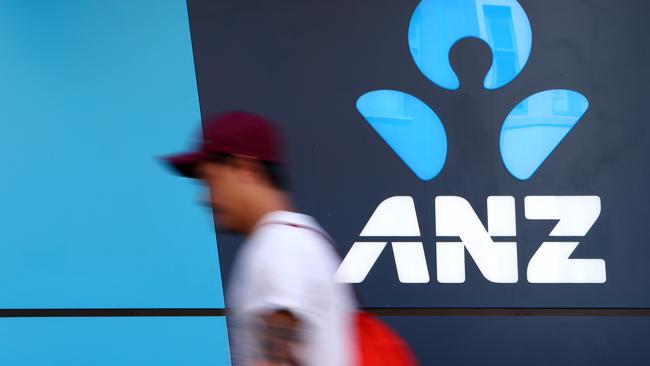ANZ says rate cuts won’t help as profit takes a hit
ANZ chief executive Shayne Elliott has poured cold water on the prospect of any economic benefit from an expected RBA rate cut next week.

ANZ chief executive Shayne Elliott has poured cold water on the prospect of any economic benefit from an expected rate cut next month, but expects the Victorian economy to snap back to life after the end of a punishing COVID-19 lockdown.
Ahead of a widely forecast easing in official rates and further monetary stimulus measures on Melbourne Cup day, Mr Elliott said the markets were already awash with liquidity.
“I’m not sold on the intended benefits — the cost of funding is not a binding constraint (on the economy),” Mr Elliott told The Australian.
His comments came as ANZ unveiled a 40 per cent slump in 2020 headline profit to $3.58bn compared to $5.95bn a year ago, as the bank set aside funds to cover for potential lending losses.
Mr Elliott said the Reserve Bank and the big commercial banks had fundamentally different objectives, but it was clear that liquidity was “overwhelming”, and the price of accessing funds was “free or close to it”.
It was unclear what a further easing in the already rock-bottom cash rate of 0.25 per cent would achieve, other than a further compression in bank net interest margins — a key driver of profits.
Mr Elliott acknowledged that some people would say: “Who cares?” However, he said investors demanded a fair return and offsetting measures would have to be taken, with retail deposits likely to come under greater pressure as they became less valuable to the banks.
In a similar vein, he also said banking levy, introduced in 2017, should be reconsidered.
While the 6 basis point levy on the bank deposit book sounded like a small imposition, it was a much greater burden in a zero-rate environment, he said.
“When I raise a deposit today, I still have to pay 6 basis points to the government,” Mr Elliott said.
“In a world where the Reserve Bank wants to make borrowing cheaper, it’s one of the big costs.”
The comments come ahead of the RBA’s monthly policy meeting next Tuesday, with markets betting that governor Philip Lowe will announce several measures to further stimulate the economy, including quantitative easing, targeting lower five-year and 10-year government bond yields, and a cut in the cash rate to 0.1 per cent from 0.25 per cent currently.
ANZ’s profit crunch, driven by a three-fold increase in credit impairment charges to $2.74bn, translated to the final dividend being slashed from 80c a share to 35c.
The annual dividend of 60c, down from $1.60 in 2019, translated to a payout ratio of 49 per cent, within the prudential regulator’s guidance of 50 per cent. ANZ was the first of the major banks with an end-September balance date to deliver its results. National Australia Bank and Westpac are scheduled to deliver results next week.

After a year which began with unprecedented bushfires and closed with waves of an unresolved pandemic, Mr Elliott was unable to present shareholders with any comfort about the future.
“What I do know, however, is we are in excellent shape to navigate whatever challenges emerge,” he said.
“ANZ has an experienced and stable management team, a strong balance sheet and prudent credit reserves to ensure we are able to support our customers, while still protecting the long-term interests of shareholders.”
While the business would not return to its pre-pandemic position, neither was management “sitting idle” and waiting for the next event to occur.
Instead, the bank was well-placed to respond to opportunities emerging as a result of accelerated structural shifts in the economy.
UBS analyst Jon Mott described the result as “reasonable, with a lot of moving parts”.
Among the more welcome aspects were a virtually unchanged tier one capital ratio of 11.3 per cent, higher provisions to cushion against inevitable loan losses when assistance packages expire around the middle of next year, and the strong run-off in business and home-loan deferrals.
ANZ shares retreated 46c, or 2.4 per cent, to $18.70, roughly in line with the 1.7 per cent decline in the overall market.
Commenting on the emergence of ANZ’s home state of Victoria from lockdown this week, Mr Elliott said the experience of other states indicated that the economic recovery would be quite sharp.
In WA, for example, spending at cafes and restaurants was now 18 per cent higher than it was a year ago, before COVID-19.
“So there will be a bounce-back; we’re very, very confident it will happen in Victoria,” the ANZ chief said.
“Our job is to actually enable that — businesses have to stock up, get their inventory, get their staff back.
“There’ll be a lot of need for working capital and all sorts of other things, and that’s exactly what we do, so there is a sense of optimism and it’ll be great … to have Victoria back on its feet and growing again.”
The early anecdotal evidence, only days old, was strong, with many restaurants now booked out until Christmas, he said.
And while it had nothing to do with Victoria’s reopening, 60 per cent of ANZ’s small business customers with deferred loans had a higher cash balance in mid-October than they did in March.
Mr Elliott said this indicated the powerful impact of assistance packages introduced by the federal government.
He said it would be a few weeks before any judgment could be made about the effect of reopening on business-loan deferrals.
The 42 per cent slide in cash profit from $6.47bn to $3.76bn saw ANZ’s return on equity plunge from 10.9 per cent to a skinny 6.2 per cent.
While credit impairment charges jumped three-fold from $795m to $2.74bn, Mr Elliott clarified that ANZ had yet to lose a single dollar as a result of COVID-19. Individual provisions were broadly the same; it was the collective provision, or expected credit losses for the future, that had increased.






To join the conversation, please log in. Don't have an account? Register
Join the conversation, you are commenting as Logout